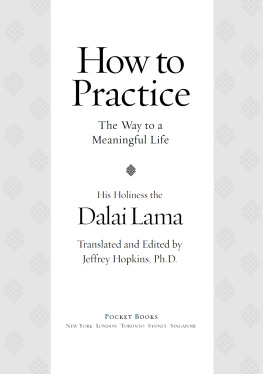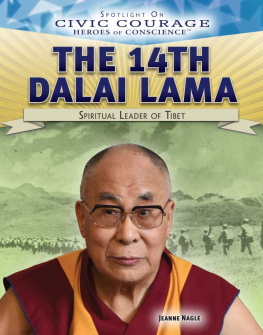Praise for Pico Iyers
The Open Road
Iyer has written one of the most thoughtful and eloquent books yet about the Dalai Lama. Considering his subject is one of the most analyzed and photographed men in the world, thats no small feat.
The Boston Globe
Allows us to imagine the Dalai Lama as something of an intellectual and spiritual adventurer, exploring fresh sources of individual identity and belonging in the newly united world.
The New Yorker
Intimate and insightful.... Succeeds as a work of biography, history and memoir.
Los Angeles Times
[Iyer has] an access and insight into the Dalai Lama that lifts his writing above the clichs that normally surround him.... Reveals more about its subject than any formal study.
The Economist
Lucid, probing and revealing, The Open Road is a meditation on the big responsibilities and big ideaspersonal enlightenment, world peace, the meaning of freedom, Tibets relationship with China and the wider worldone individual, plucked from a normal life in boyhood and named the Fourteenth Dalai Lama, has found himself having to wrestle with nearly all his life. San Francisco Chronicle
This personal portrait of the Dalai Lama provides a deeply private view of the ideas, complexities, and politics of the man.... Iyer doesnt miss a beat.
The Providence Journal
Longtime Tibet observer Pico Iyer has written a nuanced and perfectly timed account of the Dalai Lamas lifeweaving history, politics, religion and biography into this kaleidoscopic portrayal.... The Open Road reflects Iyers thirty years of keen observation and extensive reporting about the Tibetan leader.
The Hartford Courant
Pico Iyer
The Open Road
Pico Iyer is the author of seven works of nonfiction and two novels. He has covered the Tibetan question for Time, The New Yorker, The New York Times, The NewYork Review of Books, and many other publications for more than twenty years.
ALSO BY PICO IYER
Sun After Dark
Abandon
The Global Soul
Tropical Classical
Cuba and the Night
Falling Off the Map
The Lady and the Monk
Video Night in Kathmandu
THE OPEN ROAD
THE OPEN ROAD
The Global Journey of the FourteenthDalai Lama
PICO IYER
First published in Great Britain 2008
Copyright Pico Iyer
This electronic edition published 2009 by Bloomsbury Publishing Plc
The right of Pico Iyer to be identified as the author of this work has been asserted by him in accordance with the Copyright, Designs and Patents Act 1988
All rights reserved. You may not copy, distribute, transmit, reproduce or otherwise make available this publication (or any part of it) in any form, or by any means (including without limitation electronic, digital, optical, mechanical, photocopying, printing, recording or otherwise), without the prior written permission of the publisher. Any person who does any unauthorised act in relation to this publication may be liable to criminal prosecution and civil claims for damages.
Bloomsbury Publishing Plc, 36 Soho Square, London W1D 3QY
A CIP catalogue record for this book is available from the British Library
eISBN: 978-1-40880-692-0
www.bloomsbury.com/picoiyer
Visit www.bloomsbury.com to find out more about our authors and their books. You will find extracts, authors interviews, author events and you can sign up for newsletters to be the first to hear about our latest releases and special offers.
So simplify the problem of life, distinguish the necessary and the real. Probe the earth to see where your main roots run. I would stand upon facts.
HENRY DAVID THROREAU, March 27, 1848
(in his first letter to his new friend Harrison Blake)
CONTENTS
ALL THIS IS A DREAM. Still, examine it by a few experiments. Nothing is too wonderful to be true, if it be consistent with the laws of nature.
MICHAEL FARADAY, 1849
T he two young men had many things in common as they settled into the room under the snowcaps, bright Tibetan scrolls on the walls, pine-covered slopes all around. Both of them were travelersexileswho had left their homes behind and so were in a position to think about home in a new way, without the limitations of nationality or race. Both were philosophers, too, but philosophers with a keen interest in the real world and the ways in which politics and society could be transformed by being seen in a different light. Both were coming of age at a time when cultures could reach one another as never before, thanks to jet planes and television screens, and the first question before them, perhaps, was how to turn this global reality into a fresh opportunity.
The Fourteenth Dalai Lama was only twenty-four at the time, having come into India barely a year before, in March 1959, when Chinese troops had threatened to bring war to his capital of Lhasa and he had been forced to flee his native Tibet. Now, for the first time in his adult life, he was sharing a house with his mother and some siblings, relishing the chance to talk to strangers and come down from his throne as he could never have done in his old home. He loved to take walks in the high mountains in those early days, to picnic in meadows; he even started a garden as he had done in Lhasa. But every time he did, he later confessed, one of Indias notorious monsoons would sweep through, reducing all his efforts to nothing, and a part of him would miss the high, dry plateaus of Tibet.
My father, when he came into the room, was moving in the opposite direction. He had been born five years before the Dalai Lama, to Hindu parents, and had grown up in a tiny apartment in Bombay, shared with six siblings, some cousins, even the occasional neighbor. He had been trained in British Catholic schools and had so mastered the Shakespeare and Augustine they had taught him that he had won a scholarship to Oxford and now (like my Hindu, Bombay-raised mother, too) was teaching political philosophy at the ancient university. He had a rare opportunity, he knew, to bring the great Western tradition of Plato and Plotinus and Kant together with the Hinduism and Buddhism he had absorbed as a boy.
At the time he sailed back to India and requested a meeting with the newly arrived Dalai Lama, my father was deep in research on Mohandas Gandhi. The Tibetan leader had himself been thinking intensely about Gandhi, of course, as he tried to see how he could lead a nonviolent struggle against a foreign occupation and summon political sophistication in a transpolitical cause; by chance, the house in which he was staying had been lent him by the same wealthy Indian family that had lent Gandhi his final home, in Delhi, and pictures of the Indian activist of just a generation before filled the building in which the young men met. The subtitle Gandhi had chosen for his autobiographyThe Story of MyExperiments with Truthmight have applied to the Dalai Lamas story, too (he was a practical and lifelong lover of experiments), as he tried to construct a new, more durable Tibet outside Tibet and to see how he could protect the rights of his people without denying the legitimate rights of their great neighbor, as he called it, Communist China.
Five years after that first meeting, my father brought out a book, The Glass Curtain, about the centuries of delusion and projection that had separated Asia from Europe. Its foreword was contributed by his new friend, the Dalai Lama, for whom cutting through differences to a deeper commonness was always a central goal. The book was dedicatedthough it would take me decades to notice itto a little boy called Pico and to those of his generation for whom there will be no curtain.












